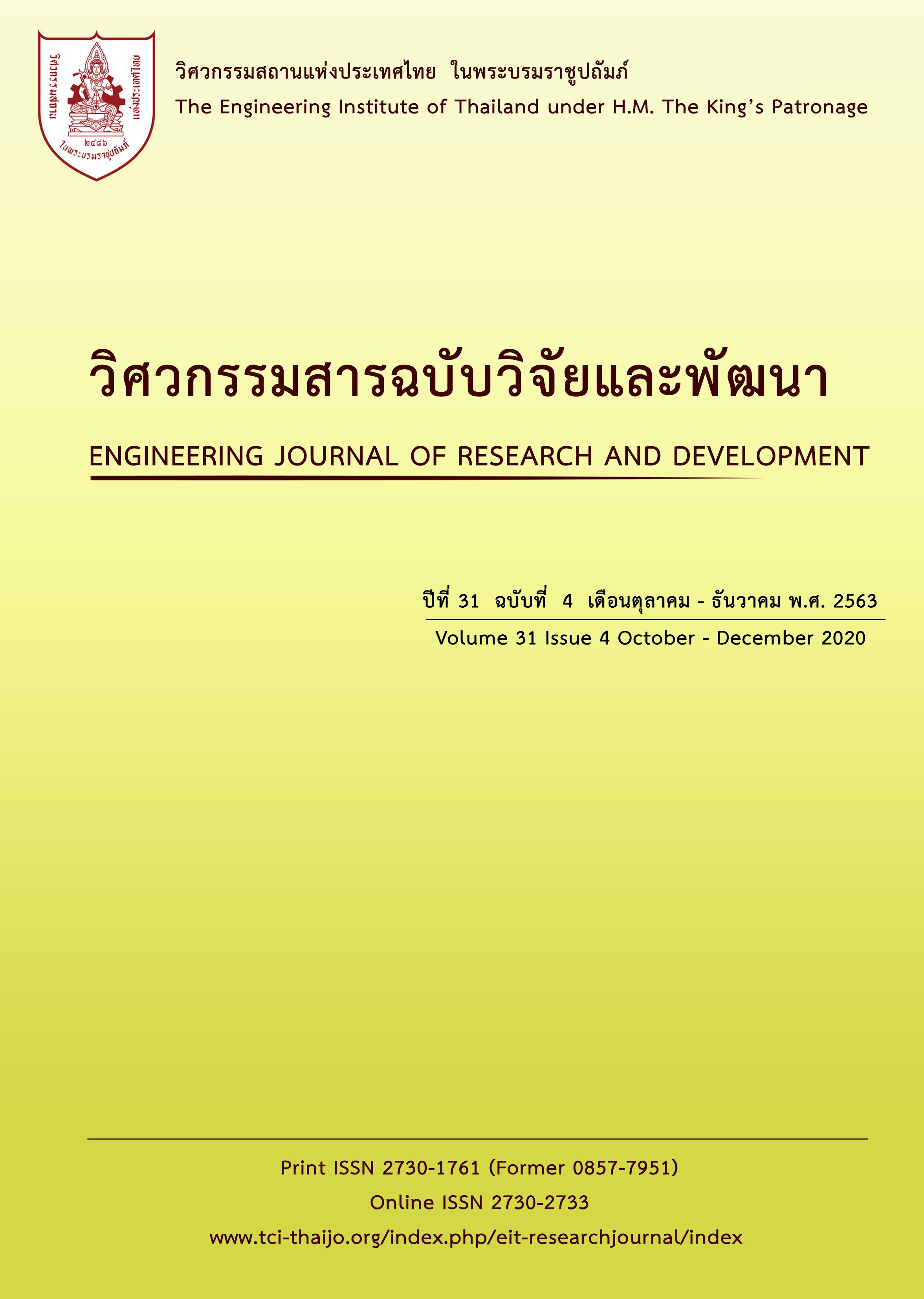REMOVAL OF HALOACETIC ACIDS (HAAs) IN WATER SUPPLY BY COAGULATION - FLOCCULATION AND ACTIVATED CARBON ADSORPTION PROCESSES
Main Article Content
Abstract
Haloacetic acids (HAAs) is a substance in the group of acids having the potential to cause cancer The acid is found in the process of water disinfection The purpose of this study are 1) to remove natural organic matters (NOMs) which is the initial substance of HAAs from the coagulation-flocculation process. In the process, PACl with the concentration of 30 mg/L mixed with cationic polymer with the concentration of 0.5 mg/L. could remove NOMS which were 96.84% turbidity and 64.42% dissolved organic carbon (DOC), 2) to remove HAAs by using Coconut shell activated carbon (GAC) to absorb. When chlorine substance with the concentration of 0.5 mg/L was added in the water in the process of coagulation-flocculation, HAA5, was 24.35 µg/L. The adsorption reaction of HAA5 and GAC was monolayer together with the chemical adsorption. And specific of surface area. The capacity of the adsorption yielded the highest value which was 44.05 µg/g. When HAA5 was removed by the column test, 100% HAAs was removed. The slow rate of the flow and the height of GAC which increased resulted in high removal ability. The ability of the adsorption was 68.38 µg/g.
Article Details
The published articles are copyright of the Engineering Journal of Research and Development, The Engineering Institute of Thailand Under H.M. The King's Patronage (EIT).
References
and its association with THMs and HAAs formation. Journal of Hydrology,2013, 476: 274-279.
[2] Pentamwa, P., Sukton, B., Wongklom, T., and Pentamwa, S. Cancer Risk Assessment from Trihalomethanes in Community Water Supply at Northeastern
Thailand. International Journal of Environmental Science and Development, 2013, 538-544.
[3] U.S.EPA. 2012 Edition of the Drinking Water Standards and Health Advisories. Washington DC, 2012.
[4] Nikolaou, A., Lekkas, T., andGolfinopoulos, S. Kinetics of the formation and decomposition of chlorination by-products in surface waters. Chemical
Engineering Journal, 2004, 100(1-3): 139-148.
[5] WHO. Guidelines for drinking-water quality, 3rd ed. Vol. 1. Recommendations: Switzerland, 2006.
[6] Harman, M., Rumsby, P., and Kanda, R. Evaluation of Haloacetic Acid Concentrations in Treated Drinking Water. UK, 2011.
[7] Uansiri, S. Determination of Haloacetic Acids in Water Samples Using Ion Chromatography. Master of Science Chemistry, Mahasarakham University, 2009.
[8] Villanuevaa, C. M., Kogevinasa, M., and Grimaltb, J. O. Haloacetic acids and trihalomethanes in finished drinking waters from heterogeneous sources.
Water Researeh, 2003, 37: 953–958.
[9] Chuang, Y.-H., Wang, G.-S., and Tung, H.-h. Chlorine residuals and haloacetic acid reduction in rapid sand filtration. Chemospher, 2011, 85(7): 1146-1153.
[10] Ratasuk, C., Kositanont, C., and Ratanatamskul, C. Removal of haloacetic acids by ozone and biologically active carbon. ScienceAs,2008, 34(3): 293.
[11] Guay, C., Rodriguez, M., and Sérodes, J. Using ozonation and chloramination to reduce the formation of trihalomethanes and haloacetic acids in drinking
water. Desalinatio,2005, 176(1-3): 229-240.
[12] Babi, K. G., Koumenides, K. M., Nikolaou, A. D., Makri, C. A., Tzoumerkas, F. K., and Lekkas, T. D. Pilot study of the removal of THMs, HAAs and DOC from
drinking water by GAC adsorption. Desalination,2007, 210(1-3): 215-224.
[13] Sacher, F., von Gunten, U., Lee, C., andSchmidt, C. Strategies for minimizing nitrosamine formation during disinfection. Water Environment Research
Foundation, 2008.
[14] US.EPA. Determination of haloacetic acids and dalapon in drinking water by liquid-liquid extraction, derivatization and gas choromatography with electron
capture detection Method 552.2, Rev. 1.0. Washington DC, 1995.
[15] Xie, Yuefeng. Analyzing haloacetic acids using gas chromatography/mass spectrometry. Water research, 2001, 1599-1602.
[16] Xu, Y., Chen, T., Liu, Z., Zhu, S., Cui, F., andShi, W. The impact of recycling alum-humic-floc (AHF) on the removal of natural organic materials (NOM):
Behavior of coagulation and adsorption. Chemical Engineering Journal, 2016, 284: 1049-1057.
[17] Matilainen, A., Vepsalainen, M., andSillanpaa, M. Natural organic matter removal by coagulation during drinking water treatment: a review. Adv Colloid
Interface Sci, 2010, 159(2): 189-197.
[18] Wu, X., Ge, X., Wang, D., andTang, H. Distinct coagulation mechanism and model between alum and high Al13-PACl. Colloids and Surfaces A:
Physicochemical and Engineering Aspects, 2007, 305(1-3): 89-96.
[19] Singer, P. C. Humic substances as precursors for potentially harmful disinfection by-products. Water Science and Technology,1999, 40(9): 25- 30.
[20] Lu, J., Zhang, T., Ma, J., andChen, Z. Evaluation of disinfection by-products formation during chlorination and chloramination of dissolved natural organic
matter fractions isolated from a filtered river water. J Hazard Mater, 2009, 162(1): 140-145.
[21] Soonglerdsongpha, S. Removal of haloacetic acid by adsorption on mesoporous silicates. Degree of Master of Science Program in Environmental
Management Interdisciplinary Program, Graduate School Chulalongkorn University, 2006.


